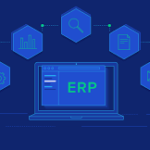In today’s fast-paced business landscape, digital transformation is no longer a choice but a necessity. It’s not a matter of if companies should adopt digital technologies, but how effectively and swiftly they can do so. In order to stay ahead of their competitors, it’s imperative for businesses to upgrade their legacy systems, and implement new, streamlined systems. For many organizations, this journey entails transitioning from antiquated, clunk, on-premise solution, to modern Cloud Enterprise Resource Planning (ERP) solutions. In this article, we’ll delve into the challenges, advantages, and best practices associated with the digital transformation path from legacy systems to cloud ERP.
The Imperative of Digital Transformation
Digital transformation is the process of leveraging digital technologies to reshape business operations, enhance customer experiences, and drive innovation. It’s no longer just a buzzword; it’s a prerequisite for survival and growth. Several key drivers underline the importance of digital transformation:
Changing Customer Expectations: In today’s marketplace, customers demand seamless, personalized, and omnichannel experiences, which legacy systems often struggle to deliver.
Competitive Pressure: Companies that embrace digital transformation gain a significant edge in terms of efficiency, agility, and responsiveness.
Data-Driven Decision-Making: Data is a valuable asset, and modern businesses must utilize data analytics for insights that drive strategic decisions.
Globalization: Expanding into new markets and operating globally necessitates scalable and adaptable systems, which legacy systems may lack.
Remote Work: The shift to remote work calls for systems that can be accessed from anywhere, making cloud solutions increasingly crucial.
The Legacy System Challenge
Legacy systems, typically on-premises and outdated, present significant obstacles to organizations embarking on digital transformation:
Lack of Integration: Legacy systems often operate in isolation, making it challenging to share data and processes across the organization.
Limited Scalability: These systems struggle to accommodate growth, requiring costly upgrades or replacements as businesses expand.
High Maintenance Costs: Legacy systems can be expensive to maintain, both in terms of IT resources and the risk of downtime.
Security Concerns: Older systems may have vulnerabilities that expose organizations to cyber threats and data breaches.
Inflexibility: Legacy systems tend to be rigid and difficult to customize or adapt to changing business needs.
The Role of Cloud ERP in Transformation
Cloud ERP solutions, like Oracle NetSuite, are pivotal in modernizing organizations and enabling successful digital transformations. They bring a host of advantages, including scalability for accommodating growth, accessibility for remote work and global collaboration, and integration capabilities that unify data and processes. These systems provide valuable data insights through robust analytics and reporting, while also offering cost-efficiency with lower upfront expenses and reduced maintenance burden. Moreover, cloud ERP providers prioritize security measures, often surpassing what on-premises systems can achieve, and they provide flexibility through high levels of customization to align with specific business processes and requirements.
The Digital Transformation Journey
The transition from legacy systems to cloud ERP is a multifaceted process that demands careful planning and execution. Here’s a step-by-step guide to navigating this transformation:
1. Assess Current State: Start by conducting a comprehensive assessment of your existing legacy systems. Identify pain points, areas for improvement, and strategic objectives.
2. Set Clear Objectives: Define clear objectives for your digital transformation journey. What do you hope to achieve? Improved efficiency, enhanced customer experiences, or streamlined processes?
3. Develop a Roadmap: Create a detailed roadmap outlining the steps and timeline for your transformation. Consider factors like budget, resources, and organizational readiness.
4. Choose the Right Cloud ERP: Select a cloud ERP solution that aligns with your business goals and requirements. Consider factors like scalability, customization options, and vendor reputation.
5. Data Migration: Plan and execute a data migration strategy, ensuring the accurate transfer of data from legacy systems to the cloud ERP.
6. Integration: Integrate your cloud ERP with other essential systems and applications, such as CRM, e-commerce, and HR software. This integration enhances data flow and process automation.
7. User Training: Invest in comprehensive user training to ensure that your team can fully utilize the capabilities of the new cloud ERP system.
8. Change Management: Implement effective change management strategies to address resistance to change and ensure a smooth transition.
9. Continuous Improvement: Regularly assess the performance of your cloud ERP system and look for opportunities to optimize processes and enhance efficiency.
Overcoming Challenges
The journey from legacy systems to cloud ERP is not without its challenges. Firstly, employees may resist adopting new technology. In order to prevent this, companies should involve employees at every step of the way, with clear communication, training, and involvement in the process.
Secondly, data migration and integration can be complex and time-consuming. Ensuring you work with an experienced solution provider will ensure that the process is smooth, and there are so mistakes. Your solution provider will also help you to map out your business processes, and ensure you are only integrating third-party systems that will benefit and improve your business. They will also ensure that you do not fall into the trap of over customisation, which can be expensive and timely.
Finally, digital transformation requires financial investment. In order to ensure you choose the right solution for you, create a realistic budget, work with different ERP providers to deeply understand the licences and their features, and explore financing options if necessary.
Conclusion
In the digital age, organizations must embrace digital transformation to remain competitive and agile. The journey from legacy systems to cloud ERP is a strategic move that empowers businesses with scalability, accessibility, integration, data insights, cost-efficiency, security, and flexibility.
While challenges exist, careful planning, a clear roadmap, and a commitment to leveraging technology to its fullest potential can enable organizations to successfully transition and thrive.








